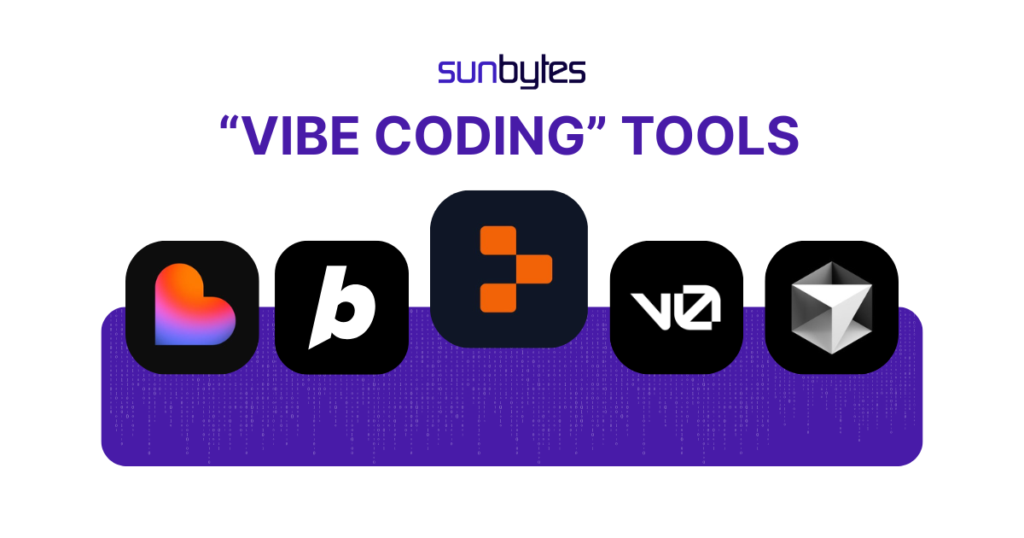Vibe coding, in short, refers to the process of coding that leverages the help of AI, and it has been making quite a buzz among developers. Creating software used to mean years of learning complex programming languages and algorithms. Today, an innovative approach called Vibe Coding is changing everything. You no longer have to write code line by line. Instead, you guide AI systems using simple, natural language. Welcome to the era where anyone can build software or products by just describing what they want.
Key Takeaways
- Vibe Coding uses AI for code generation via natural language prompts.
- It lowers the barrier to entry for software creation.
- Emphasizes “code first, refine later” for rapid prototyping.
- Clear prompts are essential for effective AI code generation.
- Users still need to review and test AI-generated code.
- Basic coding knowledge remains valuable.
- Best for prototypes and smaller apps, not complex systems.
- Security and code quality require careful attention.
- Use version control (e.g., Git) for code management.
- AI tools are expanding the developer community.
What is Vibe Coding?
Vibe Coding is an AI-assisted programming method in which you communicate with AI tools through straightforward prompts. Introduced by computer scientist Andrej Karpathy in February 2025, this revolutionary concept urges developers and non-developers alike to “fully give in to the vibes” by describing their desired outcomes and letting AI handle the complex coding.
Instead of focusing on programming languages or syntax, users simply explain the function they need in plain language. The AI interprets these prompts and generates executable code. This is true “coding without coding.”
The methodology emphasizes a “code first, refine later” mentality, prioritizing rapid prototyping and functional outputs. This lowers the barrier to entry for software creation, potentially allowing individuals with limited technical expertise to build applications. Consequently, the developer’s role evolves from manual coding to guiding, testing, and refining AI-generated code.
Vibe Coding & AI
Shaping Software Development in 2025
Developers Embracing AI Tools
A significant majority of developers are integrating AI into their workflows.
76%
are using or plan to use AI tooling.
The Billion Developer Horizon
1 Billion
developers predicted by 2030, with AI as a catalyst (GitHub CEO).
AI Coding: Security Under Scrutiny
Flagship AI models are not yet ready for full coding automation due to security flaws in generated code (Baxbench).
Startups Riding the AI Wave
About 25% of new YC startups have codebases almost entirely AI-generated.
95%
of code written by AI.
The Rise of Prompt-Driven Development
On platforms like Replit, 75% of users rely solely on prompts, never writing code themselves.
Vibe Coding Productivity: Hype vs. Reality
Claims of 10x to 100x productivity are common, but met with skepticism. The “80/20” rule often applies.
The 80/20 Functionality Trap
Power of Secure Coding
Training leads to a median 53% reduction in vulnerabilities.
Secure devs fix issues 2-3x faster.
Boosting Developer Experience
- +42% Productivity
- +50% Innovation
- -50% Tech Debt
AI’s Exponential Leap
AI quality & capability are growing at a predictably exponential rate.
GitHub Copilot’s Reach
1.3M+
users by early 2024, showing massive AI assistant adoption.
Vibe Coding Vs Traditional Coding
Imagine having a personal AI assistant or a “junior developer” at your service. You simply describe what you want, and the AI creates the code, edits it, and even helps debug based on your instructions. Traditional software development required extensive coding knowledge, but Vibe Coding shifts the focus to clearly articulating desired outcomes. Karpathy’s “fully give in to the vibes” captures this shift perfectly.
| Aspect | Vibe Coding | Traditional Coding |
| Development Speed | Faster prototyping and development – can turn ideas into working apps quickly | Longer development time – writing, testing, and debugging code from scratch can take weeks or months |
| Cost | Lower costs due to reduced need for skilled developers and faster development cycles | Higher costs – skilled developers are expensive and require larger teams and extended development cycles |
| Flexibility & Control | Potential security vulnerabilities, as AI-generated code might not meet security standards | Unlimited customization and full control over every aspect of the software |
| Scalability | Limited scalability for complex, enterprise-level applications | Superior scalability – can handle large-scale and mission-critical applications |
| Performance | May not follow best practices or include proper optimization | Superior performance optimization with direct control over the codebase |
| Security | High dependency on AI platforms and tools like ChatGPT, Replit, and Cursor | Full control over security implementation and compliance protocols |
| Learning Curve | Minimal – focuses on prompt engineering and natural language communication | Steep learning curve requiring extensive training and experience |
| Maintenance | Challenging – users may not understand the generated code for debugging complex issues | Complex but manageable – requires ongoing developer support but developers understand the codebase |
| Best Use Cases | Quick prototypes, smaller apps, weekend projects, and starting points for experienced developers | Complex but manageable – requires ongoing developer support, but developers understand the codebase |
| Vendor Dependency | High dependency on AI platforms and tools like ChatGPT, Replit, Cursor | Low risk of vendor lock-in since you own the code |
| Code Quality | Variable – depends on AI capabilities and may require human oversight for production use | Consistent quality when following best practices, though prone to human error |
Why Vibe Coding Appeals to Non-Coders
Lower Barrier to Entry
With Vibe Coding, the complex syntax and technical jargon of traditional programming are no longer barriers. Anyone who can articulate their ideas can now build functional software.
Faster Prototyping
Projects can move rapidly from concept to functional prototype, often in hours rather than weeks. This makes Vibe Coding perfect for quick tests and experiments.
Citizen Development
Business users and non-technical team members can create custom tools by simply explaining their workflows or problems. This aligns perfectly with the rise of citizen development, where anyone can contribute directly to building digital solutions.
How Vibe Coding Works for Non-Coders: The Step-by-Step Guide
Step 1: Select Your AI Coding Platform:
Begin by choosing an AI coding assistant that fits your technical needs, performance
expectations, and budget. Popular tools include:
- Replit: An online IDE where 75% of users never manually write code, relying entirely on AI features. Replit is capable of generating front-end, back-end, and database configurations from prompts. Known for its instant app building and deployment.
- Lovable: Lovable.dev is an AI-powered platform that allows users to build full-stack web applications without needing coding expertise. It enables users to create apps simply by describing what they want in natural language
- Cursor: An AI-powered code editor (based on VS Code) with integrated coding assistance, allowing natural language coding and task delegation to various AI models.
- Microsoft GitHub Copilot: Evolved from a code completion tool to offer vibe coding features within editors like VS Code, suggesting code and generating functions from comments. Expanding into a chat mode (“Copilot X”) for high-level instructions and bug fixing.
- ChatGPT (OpenAI): A conversational AI that can generate code snippets, solve programming problems, and write small programs based on user prompts. Newer versions can execute code and manage files.
- Claude (Anthropic): Noted for its large context window and strong coding capabilities. Claude Code is a dedicated alternative.
- Emerging Platforms: Pythagora, Bolt, Cline, Aider by Aider AI, Bolt.new, Lovable, v0 by Vercel, Trickle AI, Tempo, and Softgen are being specifically developed for vibe coding.
Consider factors like language support, ease of use, and preference for cloud-based or local IDE solutions. Experiment with free tiers or trials to find the best fit.

Step 2: Set Up Your Development Environment:
Once you’ve chosen a platform, configure your development environment. This may involve installing editor extensions (e.g., for GitHub Copilot or Cursor) or registering on a website (e.g., Replit). Ensure necessary API keys or access tokens are properly configured for seamless AI integration into your workflow.
Step 3: Define Requirements with Effective Prompts:
This is central to vibe coding. Describe your desired software in natural language. When starting a new project or file, write a detailed prompt outlining the program or feature’s functionality.
- Focus on Intent: Instead of focusing on specific syntax, articulate the problem you want to solve or the desired outcome.
- Be Specific: Provide clear and precise instructions. For example, instead of a general request, a detailed prompt like the QR code generator example is more effective.
- Set Rules (Optional): For more complex projects, you can provide the AI with specific guidelines to direct its approach. Well-crafted prompts are clear, contextually relevant, and goal-oriented.
Step 4: Generate, Review, and Run the Initial Code:
The AI model will produce code based on your prompt. The generation time will vary depending on the complexity. After generation, carefully review the code and run it to assess its functionality.
- Treat as a First Draft: Recognize that the AI’s output is an initial attempt.
- Test Functionality: Even if you don’t fully comprehend the code, test the basic features to see if it runs without errors and achieves the expected outcome. This is a crucial step in evaluating the AI’s work.
Step 5: Iterate and Refine Through Conversation
The first code version will likely require adjustments. This iterative process of providing feedback and conversing with the AI is key to vibe coding.
- Provide Specific Feedback: Clearly describe the necessary changes or improvements, such as adding features, refining the user interface, or fixing bugs.
- Continuous Cycle: The AI will modify the code based on your feedback. You then test the updated version, and this cycle continues until the software meets your requirements.
- Provide Context: When requesting changes, especially in later stages, give the AI relevant context, such as referencing specific files or summarizing existing code.
This rapid iteration allows for a fluid and creative development process, akin to sculpting software through continuous feedback.
Step 6. Deploy or Integrate the Final Code
Once you are satisfied with the software, you can deploy your project or integrate it into a larger system. Online tools may provide a live URL. For local tools, you’ll need to host the code or share the repository. It’s highly recommended to save the final code in a version control system like Git for future updates and reference, as the AI-generated code remains valuable.
“The term vibe coding comes from the fact that we are trying to get in a vibe of creating something new actually without focusing on software itself. So it will rapidly increase the prototyping market and expanding new ideas, and also making niche applications available because people just can create them at home basically. So for the technical people, it might actually not add that much value. It will add more value for business people just talking about the ideas without actually knowing about coding” – Koen Klasing – CTO and Co-founder of Sunbytes
Real-World Examples of Vibe Coding
Non-developers are building amazing things:
- Personal Tools: Like Kevin Roose’s LunchBox Buddy, which suggests recipes based on your fridge contents.
- Rapid Prototyping: Creating web apps quickly, such as podcast calculators or event websites.
- Startups: About a quarter of recent Y Combinator startups rely almost entirely on AI-generated code, rapidly launching MVPs.
- Educational Use: Students grasp programming concepts without struggling with complicated syntax.
The Reality Check: Not Pure Magic (Yet)
Despite its ease, Vibe Coding isn’t entirely magic. So, what are some key considerations and best practices for AI-assisted coding
Prioritize Security
AI-generated code can introduce vulnerabilities, including bugs, misconfigurations, and non-compliant code. Developers who lack security awareness may unknowingly worsen these risks. Since AI lacks inherent understanding of an application’s security context, it may produce flawed code, such as unsanitized inputs or outdated libraries.
- Adopt a “shift left” security approach, prioritizing security early in development.
- Utilize modern tools to scan for vulnerabilities during code creation.
- Never blindly approve AI-generated changes involving file creation, editing, or shell commands.
- Security leaders should oversee AI adoption with proper governance frameworks, human-in-the-loop practices, and auditability standards.
- Use advanced reasoning models to review AI-generated code for vulnerabilities and best practices.
- Review large codebases in sections for thorough inspection.
- Developers must possess a solid understanding of secure coding principles to mitigate risk.
Ensure Code Quality, Maintainability, and Debuggability
While AI-generated code can accelerate development, it is not always optimal. Logic flaws, inefficiencies, and incomplete error handling may exist, leading to issues that are difficult to debug. Code that appears functional on the surface can obscure deeper problems, making long-term maintenance challenging.
To avoid these pitfalls, developers should conduct thorough testing, implementing additional test cases to cover edge scenarios and integrating logging mechanisms for better debugging. Even if the code is unfamiliar, developers should make an effort to read and understand it, testing for basic functionality and errors.
- AI-generated code for critical application components should be manually reviewed by experienced developers.
- Projects should be built incrementally using small, well-defined prompts.
- Refactoring and modularization are necessary after AI-assisted code generation.
- Developers should establish coding standards and incorporate them into prompts for consistency.
- Implementing guardrails and rules helps maintain quality and reduce complexity risk.
- AI-assisted coding should complement traditional software engineering practices.
Cultivate Understanding and Continuous Learning
While AI offers powerful assistance, developers should avoid excessive reliance on it for coding tasks, as this can hinder their skill development. Fundamental coding knowledge remains essential, particularly in areas such as logic, debugging, and architecture.
Instead of using AI passively, developers can treat AI-generated code as a learning opportunity. Asking AI to explain its choices can provide valuable insights, while attempting independent implementation ensures that coding skills remain sharp. Additionally, being familiar with coding vocabulary and conventions is important, as AI may not always adhere to best practices perfectly.
Optimize Process and Workflow
Effective AI-assisted development requires a thoughtful and iterative approach. Developers should engage in interactive workflows, providing clear, specific, and context-relevant prompts to guide AI responses. In later project stages, referencing existing code is particularly important when requesting changes.
To maintain structure and clarity, developers should document prompts and AI actions, either in comments or a separate document, to create a comprehensive project specification. For complex projects, rules for AI usage should be defined, and previous conversations and known issues should be documented to enhance efficiency.
Using version control systems, such as Git, is crucial for tracking code changes systematically. This ensures transparency and allows developers to revert to previous versions if necessary.
Looking to the Future
According to GitHub CEO Thomas Dohmke, AI tools could increase the global developer community to one billion by 2030. Already, 76% of developers are using or plan to use AI tools, driven by the productivity gains reported (though some skepticism remains around claims of 10x or 100x improvements).
While the AI-generated code may not be perfect, its capabilities are rapidly improving. Platforms like GitHub Copilot have seen significant user adoption, highlighting growing trust and reliance on AI assistance in software development.
Vibe Coding marks a transformative step in software creation, making it accessible, fast, and innovative. However, users must balance AI’s power with diligent oversight. Clear prompts, thorough testing, and ongoing learning are essential to harnessing AI’s full potential.
Ultimately, Vibe Coding is not a magic wand, but in capable hands, it can open incredible possibilities for developers and non-developers alike.
Applying AI to the development process can cut time by 2x. However, there’s always a need for human surveillance. That’s where our team jumps in. We incorporate AI into our workflow, but also wrap it into a continuous human feedback loop to ensure quality assurance.
Wanting to dig deeper into how we turbocharge your product development with AI? Contact us today for a free consultation
Frequently Asked Questions
Vibe Coding is an AI-assisted programming method where users communicate with AI tools using natural language prompts to generate code, rather than writing code line by line.
Vibe Coding is for both developers and non-developers, aiming to lower the barrier to entry for software creation. It allows those with limited technical expertise to build applications.
Traditional coding involves writing code manually using specific programming languages. Vibe Coding uses AI to generate code based on user prompts, requiring less technical knowledge. It emphasizes rapid prototyping and is faster, but may offer less control and scalability.
Benefits include a lower barrier to entry, faster prototyping, and enabling citizen development where non-technical users can create custom tools.
Popular platforms include Replit, Lovable.dev, Cursor, Microsoft GitHub Copilot, ChatGPT (OpenAI), and Claude (Anthropic).
Yes, potential risks include security vulnerabilities in AI-generated code, issues with code quality and maintainability, and the need for thorough testing and review.
Let’s get started with Sunbytes
Let us know your requirements for the team and we will get back to you right away.


